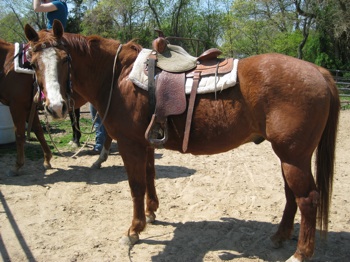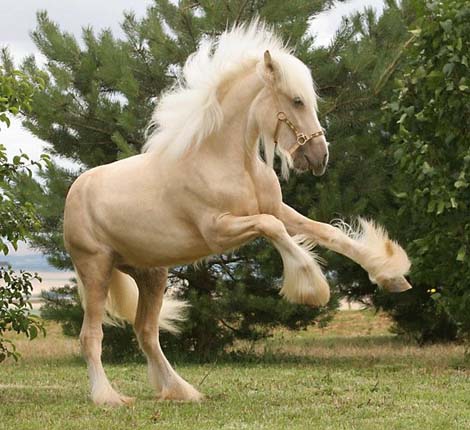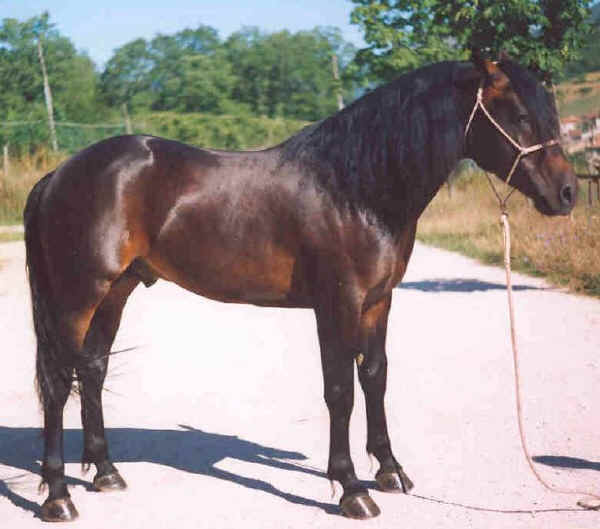Breeds of Horses With Pictures Biography
Source(Gogle.com.pk)Breed History
Learn the history of the world's most popular breed of horse.
The sorrel Quarter Horse is an ideal for the breed. Greek mythology records the epic exploits of a wonderful winged horse named Pegasus. The stories of early Texas cow country speak of another legendary horse. He was called Steel Dust, and like Pegasus, he could fly, but without ever leaving the ground.
Foaled in Kentucky, a descendent of the great Sir Archy, Steel Dust came to Texas as a yearling in 1844. His progeny and his legend spread as cowboys drove Longhorns up the trails from Texas and opened the Great Plains to ranching. The name Steel Dust came to identify an entire breed of horse; they were called “Steeldusts,” the cowboy’s favorite kind. They were heavy-muscled horses, marked with small ears, a big jaw, remarkable intelligence and lightning speed up to a quarter of a mile. Steel Dust was an American Quarter Horse. He and his kind would achieve fame in proportions every bit as magnificent as that of the mythical Pegasus.
But the story of the Quarter Horse begins long before Texans started tying their ropes and hard and fast to the saddle horn. The origins of the breed can be traced to Colonial America. When our forefathers weren’t dumping tea in the Boston Harbor and fighting Indians or Redcoats, they did enjoy a horse race. In the beginning, they ran the English horses with which they plowed and rode every day.
It wasn’t long before the Colonial farmers down in the Carolinas and Virginia began to trade for a faster horse that was being bred by the Chickasaw Indians. These quick Indian ponies were Spanish Barbs, brought into Florida by early Spanish explorers and colonists. This was the same horse ridden by the conquistador Cortez in the conquest of Mexico; the same that Coronado rode in his search for the golden cities in the American Southwest. This was a type of horse produced from the cross of the North African Barb and native Spanish stock following the Moorish invasion of Spain, which began in the year 710.
There is evidence that the Spanish Barbs obtained from the Chickasaws were crossed with the Colonists’ English stock as early as 1611. Over the next 150 years, the product of this breeding would come to be known as the “Celebrated American Quarter Running Horse.” The term “Quarter” refers to the distance, a quarter of a mile, most commonly run in Colonial racing, often on the main streets of small villages.
By the middle of the 18th century, it was apparent that the Colonists were in America to stay. They hadn’t all been eaten by wild animals or scalped by Indians. They had carved out their farms, plantations and towns all up and down the Atlantic seaboard. The tight-lipped Puritans of the Northeast had more time now to spend in church, and the southerners could pay more attention to their passion for fast horses.
Back in England, horse racing was being revolutionized by a stallion known as The Godolphin Arabian. This horse had been imported to England in 1728 and is acknowledged as one of the three foundation sires of the Thoroughbred. Prosperous Colonial planters wondered what the blood of these four-mile racers could do for their own short sprinters.
In 1752, John Randolph of Virginia imported a grandson of The Godolphin Arabian, called Janus. When Janus was bred to Colonial mares bearing the blood of the Chickasaw horse, the result was the prototype of the American Quarter Horse. While it can not be said that Janus founded the breed, it can be argued convincingly that he shaped and formed it significantly. A long-course racer himself, Janus stamped his foals with speed over short distances, as well as the ability to pass that speed through successive generations. “Compactness of form, strength and power” were the traits associated with the get and progeny of Janus.
At the same time Janus’ blood was improving the “short horses,” those which ran the quarter mile, other Colonial horsemen were adopting the English fashion for long-course racing of distances up to four miles. Simultaneous with the development of the Quarter Horse, the American Thoroughbred was also evolving with imported stallions like Fearnought.
Following the American Revolution, the Thoroughbred gained the upper hand in popularity along the Atlantic seaboard. There was a permanence in this part of the new republic. Life was a long past the stage of a day-to-day struggle for survival in a bleak, hostile land. Long-course racetracks and manicured breeding farms for the tall, sleek distance horses became an indulgence for wealthy men whose clothes were tailored in London.
The short horses echoed a pioneer experience. They were quick, tough and hardy – traits necessary and suited to life on a wilderness frontier. They could carry a man about his business all week long and then race hard on the weekend. The Quarter Horse moved west with the men who craved wide-open spaces, to the Midwest, to Texas and out onto the Great Plains.
One other great stallion put his stamp on the Quarter Horse during this period. His name was Sir Archy, sired by the imported stallion Diomed, and foaled in 1805. Sir Archy’s sons and daughters would be the most important influences in the development of Quarter Horses during the next half century. One of Sir Archy’s sons was the great Copper Bottom, brought to Texas in 1839 by General Sam Houston. Both Steel Dust and Shiloh, foundation stallions of the modern Quarter Horse, trace back to Sir Archy. Two other stallions which would contribute to the short-horse bloodlines around this same time were Printer and Tiger.
The final ingredient in the genetic formula that produced the Quarter Horse was to be found west of the Mississippi River. It was the Mustang, a free-roaming, far-ranging wild descendent of the Barb, introduced into the American Southwest by Spanish explorers, missionaries and settlers. These were the horses that made the Plains Indian into the toughest mounted warrior the world had ever seen.
When crossed with the descendents of Janus, Sir Archy, Printer and Tiger, the western Mustang added the last important shot of hybrid vigor to complete the creation of a horse unique to America … the American Quarter Horse.
This was the horse that broke prairie sod where farms would be, carried buffalo hunters across the Llano Estacado, and made up the remudas of cow outfits from the Rio Grande to the open ranges of Alberta. It was a horse ideally suited by physique and temperament to the challenge and hardship of winning the West.
Quarter-mile horse racing was as much a part of the early West as quilting bees and barn raising. From the farm country of Illinois and Ohio, over in the hills of Kentucky, Missouri and Arkansas, through the Indian Territory and the bayou country of Louisiana, and on down into Texas, men were ever ready to match their horses for a jug of corn whiskey, or real money.
If Texas can’t lay claim to the genesis of the breed, there is little dispute that it was in Texas that the Quarter Horse found a natural home. Up to now the primary value of the animal had been as a short racer. In Texas, he also became a cow horse. For it was in Texas that the western range cattle industry had its origins, and it was the Quarter Horse that took farm boys out of cotton patches, made them into cowboys and carried them up the Longhorn trails into history.
Just what is an American Quarter Horse? If you have ever seen a horse in one of rodeo's timed events, been along for work on a ranch or watched a Western on the big or small screen, nine times out of 10 you have witnessed an American Quarter Horse. Click here to see the physical specs of an American Quarter Horse.
Most all of the important Quarter Horse lines were represented in the open range and trail-driving era in Texas. The legendary Steel Dust came to Texas around 1844, and five years later, the great horse Shiloh also arrived. Shiloh’s son Billy, out of a daughter of Steel Dust, became the fountainhead of Texas Quarter Horses.
The range cattle industry began to develop in earnest following the end of the Civil War. At first, wild cattle were gathered in the brush country of South Texas, thrown together into herds and driven north to the railroad in Kansas. Cowmen and cowboys alike prized the Quarter Horse. This was the one that could get the job done, roping wild cattle in the brush, moving herds up the Chisholm Trail and then racing against others of their own kind down the dusty streets of Kansas cowtowns like Dodge City and Abilene.
It was a time, when, as they used to say, “a man afoot is no man a’tall.” The cowboy’s favorite was the Quarter Horse, and he called them all “Steeldusts,” after the great stallion whose racing triumphs were known throughout cow country.
In the second phase of the range cattle industry, ranching was established all across the Great Plains. Good horses were as important to a successful ranch operation as water and grass. The men who opened the Plains to ranching bred good horses long before they tried to improve their cattle. They recognized the value of the horses that the Texans called Steeldusts. Many of these early cowmen knew what they needed, and they bred their cow horses with a purpose. Quarter Horses could do the job, and they bred true. The cowman who recognized this was satisfied, and he kept the blood pure.
From Colonial sprint horse to open range cow horse, these race and ranch roots provided the foundations upon which the American Quarter Horse stands. A large debt is owed to the men who, without the benefit of a breed registry or formal stud book, appreciated the merit of these fine horses, preserved the integrity of the blood and perpetuated the breed.
These were men like Coke Blake, who spent a lifetime improving the Cold Deck strain of Steel Dust and Billy horses. His greatest horse was a grandson of the original Cold Deck, Tubal Cain, who Blake said, had the “eye of an eagle and the step of a deer.” The reputation of the Blake horses spread to every corner of horse country.
The most steadfast and eloquent of all those who championed the Steel Dust kind was Dan Casement of Kansas and Colorado. Casement’s foundation horse was Concho Colonel, a descendent of the Billy horse line that goes back to Steel Dust and Shiloh. Casement was passionate when it came to defending the traditional “bulldog” type of original Quarter Horse. He was to become an instrumental figure in organizing the American Quarter Horse Association.
Down in South Texas there were men whose names will forever be linked to the development of the Quarter Horse. They were Ott Adams and George Clegg, both of whom believed that speed was the essential quality in a Quarter Horse, whether you ran on the track or roped steers in the pasture or arena. Adams’ two most famous horses were Little Joe, by Traveler, and his son, Joe Moore. Among Clegg’s greatest horses were crosses of the Billy line with great stallion Peter McCue. Using the Billy line of Rondo mares, Clegg bred such horses as Old Sorrel, the foundation sire of the King Ranch Quarter Horses. Ott Adams and George Clegg left indelible marks on the breed.
The first man to actually attempt to define the Quarter Horse as a distinct breed was William Anson. He was born in England, grew up around fine horses and was a good polo player. At the age of 21, Anson came to America and established a ranch near Christoval, Texas. He was fascinated by the quick, smart cow horses with which he came in contact and began to trace their origins. Anson published the first information that linked the western cow horse to its Colonial beginnings. During the Boer War, Anson bought horses all over Texas for sale to the British government. This gave him the opportunity to put together a good band of Quarter Horse mares for himself, which he bred to his Billy horse, Jim Ned, and Harmon Baker, a son of Peter McCue.
Another man whose horses contributed greatly to the development of the breed was Samuel Watkins of the Little Grove Stock Farm in Illinois. Watkins was a racehorse man, and he believed in the Steel Dust line. He bred Jack Traveler, a son of Steel Dust, to June Bug, Steel Dust’s half-sister, and got the great mare Butt Cut. After a brilliant racing career, Watkins bred Butt Cut to Barney Owens, a son of Cold Duck which was himself a Steel Dust-Shiloh cross, and got a colt he named Dan Tucker. It was from Watkins that many of the great Texas breeders got their foundation horses. Harmon Baker, Hickory Bill and the fabulous Peter McCue all came from Little Grove Stock Farm in Illinois.
Coke T. Roberds was another man who kept the faith when it came to preserving the original blood. Born in Texas, Roberds grew up cowboying around Trinidad, Colorado, and began breeding horses in western Oklahoma about 1898. He acquired a fine band of Steel Dust mares and, after moving back to Colorado, bred them to his stallion, Old Fred, which traced back to Steel Dust and Shiloh. Roberds said that you could breed Old Fred to a boxcar and get a racehorse. Roberds was also the last owner of the great Watkins horse, Peter McCue.
Blake, Casement, Adams, Anson, Clegg, Watkins, Roberds and others like them all recognized the qualities of the Quarter Horse. They knew how to breed to the best advantage, and they were aware of the common denominators in the backgrounds of the best horses. It was as if these men had made a covenant with the horses called “Steeldusts.” Dedicated efforts to honor the covenant would lead to the organization of the American Quarter Horse Association.
This article is an excerpt from "They Rode Good Horses: The First Fifty Years of the American Quarter Horse Association," which can be purchased from Quarter Hor
Breeds of Horses With Pictures for Kids Black and White to Color Funny Hd Wallpapepr Images Pics

Breeds of Horses With Pictures for Kids Black and White to Color Funny Hd Wallpapepr Images Pics

Breeds of Horses With Pictures for Kids Black and White to Color Funny Hd Wallpapepr Images Pics

Breeds of Horses With Pictures for Kids Black and White to Color Funny Hd Wallpapepr Images Pics
Breeds of Horses With Pictures for Kids Black and White to Color Funny Hd Wallpapepr Images Pics

Breeds of Horses With Pictures for Kids Black and White to Color Funny Hd Wallpapepr Images Pics

Breeds of Horses With Pictures for Kids Black and White to Color Funny Hd Wallpapepr Images Pics
Breeds of Horses With Pictures for Kids Black and White to Color Funny Hd Wallpapepr Images Pics
Breeds of Horses With Pictures for Kids Black and White to Color Funny Hd Wallpapepr Images Pics

Breeds of Horses With Pictures for Kids Black and White to Color Funny Hd Wallpapepr Images Pics
Breeds of Horses With Pictures for Kids Black and White to Color Funny Hd Wallpapepr Images Pics

Breeds of Horses With Pictures for Kids Black and White to Color Funny Hd Wallpapepr Images Pics
Breeds of Horses With Pictures for Kids Black and White to Color Funny Hd Wallpapepr Images Pics

Breeds of Horses With Pictures for Kids Black and White to Color Funny Hd Wallpapepr Images Pics
Breeds of Horses With Pictures for Kids Black and White to Color Funny Hd Wallpapepr Images Pics

No comments:
Post a Comment